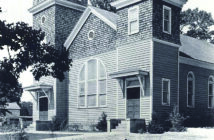A war between Chesterfield residents and a large black bird that weighs between four to five pounds with a wingspan of five feet has been ongoing since 1999. Mainly, users of the Dutch Gap Boat Landing have seen black vultures overrun the area and wreak havoc on their vehicles.
In their most recent attempt to disperse the vultures, U.S. Department of Agriculture (USDA) and Virginia Game and Inland Fisheries (DGIF) officials have hung dead vulture carcasses from light poles around the Dutch Gap Boat Landing. Some say it has been effective but others disagree.
Officials’ hands are tied on the issue since turkey and black vultures are federally protected by the U.S. Fish and Wildlife Service Migratory Bird Treaty Act; still, almost 1,500 of the birds over the years have been trapped at Dutch Gap and later euthanized.
According to DGIF the vultures have been gathering at the boat landing since the 1980’s. As the recreational area increased in popularity, complaints about the feathered residents began to arise.
“We were here at the boat landing about twelve years ago,” said Charles Fleming, a boater who, along with Tina Fleming, were preparing to try out their new boat on Friday, “It was really bad then (twelve years ago). We went out on our boat then and when we came back, vultures were sitting on my truck and the boat trailer. They were tearing the rubber from around my windshield wiper blades. They also had pooped all over my truck.”
Dominion Power has also reported that the birds are roosting on towers and that the excrement is creating a safety hazard.
So, what has been done to rid the area of the vultures?
Around the year 2000, Virginia Wildlife Services office of the USDA became involved and began a program of harassing vultures with pyrotechnics (handheld lasers and flares) and according to DGIF limited shooting to reinforce harassment.
USDA attempts at harassing the birds failed to disperse them, so in August 2002, USDA trapped and euthanized 375 black vultures at Dutch Gap.
USDA continued their harassment program on the birds that remained, with Dominion also taking part in the program. This time propane cannons were also used. The vulture population was reduced significantly and many birds left to find new roosting sites, but some remained.
Once again, this time between December 2003 and January 2004, USDA trapped and euthanized 365 vultures at Dutch Gap.
Aggressive efforts to frighten away the birds were initiated again between late summer and early fall of 2004.
From June to July 2005, according to DGIF, “USDA harassed the Dutch Gap vultures using pyrotechnics, paintball guns, shooting and effigies (fake vultures hung from trees and light poles) to disperse the birds, but once again the effort failed.”
The renewed efforts failed spelling death for the birds as USDA trapped and euthanized 540 black vultures. Of the trapped birds twenty vultures were tagged and released. According to DGIF three of these tagged birds continue to be seen at Dutch Gap.
The vulture’s diet consists primarily of dead and decaying flesh or carrion.
On March 8 this year, a visit to Dutch Gap Boat Landing revealed a flock of black and turkey vultures gathered at the boat landing and they appeared very interested in something on the ground near the boat dock. Closer investigation found a deceased whole catfish. On the opposite side of the dock, another deceased whole catfish lay where it had been discarded, and soon a group of vultures began to pick it a part.
Discarded fish scraps and whole fish attract the vultures and entice them to stay. Trash strewn about the boat landing is also an attractant, according to DGIF officials.
Dutch Gap also hosts conditions that are attractive breeding ground for the birds. Vultures lay eggs, usually two, directly on the ground, in rocky crevices, in thickets and in old buildings rather than building a nest. The eggs are laid between February and April and are incubated for 38-39 days. The young are slow growing and do not fledge until 75-80 days of age. It is estimated that vultures do not breed until they are five to eight years old. It is not known if any vulture eggs have been discovered at Dutch Gap.
According to the Vulture Society, “Vultures are very docile and misunderstood and are beneficial to mankind.”
The Society says that vulture stomachs contain digestive acid that kill virtually all bacteria and viruses.
Vultures not only gather at Dutch Gap but can be seen throughout the county, generally the birds will be devouring an animal carcass that has been struck by a vehicle and is in or near a roadway, or in a field feasting on their find.
The struggle to find a solution for the Dutch Gap vultures goes on, but for the birds the future is not promising.

